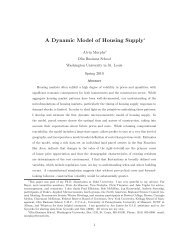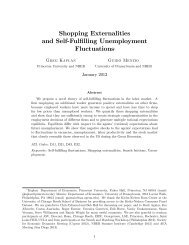Answer Sheet
Answer Sheet
Answer Sheet
- No tags were found...
Create successful ePaper yourself
Turn your PDF publications into a flip-book with our unique Google optimized e-Paper software.
(a) If you use relative PPP as your guide what should the new value of the pound be? Explainhow you made this decision.brief answer Relative PPP says that exchange rate movements are driven by inßation differentials.If inßation was double in the UK than in the US the exchange rate should increaseby 50%. Let e be the number of dollars it takes to buy a pound. Thene t − e t−1e t−1= π US − π UK = −50%.Since e t−1 =$5,e t =$2.5, according to relative PPP.(b) Why might it be a bad policy to rely solely on relative PPP as a guide here? What factorsmight call for a smaller or greater real depreciation than PPP suggests? Explain.brief answer The war may have caused structural changes that would impact the real exchangerate. For example, since the war hit the UK much harder, it may have impactedthe economy much more severely. Government spending on the military in Britainwas much higher. These are non-traded goods. Productivity may have been hurtrelatively in Britain as well due to the need to convert factories for war use. The realcost of living most likely increased greater in the UK, so the dollar should strengthenin real terms by more than just the difference in inßation rates. Hence, if the pound isset according to relative PPP it may be overvalued; a real depreciation of the poundis needed. Maintaining the prewar parity could cause problems for the economydown the line. 33. (30%) It is typically observed that when the Federal Reserve announces that the money supplyactually grew more quickly than expected in the preceding week that nominal interest rates rise.This seems to be a puzzle. Why? The two most common explanations for this use: (i) theFisher effect and expected inßation, and; (ii) expectations of future Fed policy to bring themoneysupplyintoline.(a) How does the ”Fisher effect explanation” explain why nominal interest rates rise?brief answer If the money supply has grown more rapidly then people expect higher inßation.Since the Fisher effect says that i = r + π e , if expected inßation increases so doesthe nominal interest rate.(b) How does the ”expectations about future policy explanation” explain why nominal interestrates rise?brief answer If money growth was greater than predicted investors may expect that money growthwill tighten in the future. With lower money growth and lower liquidity interest ratesshould rise. It is not higher expected inßation, but tighter liquidity that is causinginterest rates to rise, by operating on real interest rates.3 In fact, Great Britain restored the pound to its pre-war parity (actually $4.86 to the pound) only in 1925 (withChurchill as Chancellor of the Exchequer). The pound was seriously over-valued. For this parity to stick Britishprices would have to fall. Instead Britain went into depression, there was a General Strike that was eventuallysuppressed and Churchill fell from power, only to return at the onset of WW2.3
















